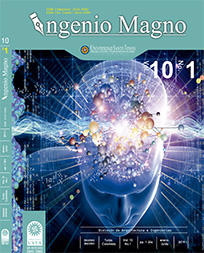Test bank design for agglomerated material
Main Article Content
Abstract
Downloads
Article Details
DECLARATION OF ORGINIALITY OF SUBMITTED ARTICLE
With this document, I/We certify that the article submitted for possible publication in the institutional journal INGENIO MAGNO of the Research Center Alberto Magno CIIAM of the University Santo Tomás, Tunja campus, is entirely of my(our) own writing, and is a product of my(our) direct intellectual contribution to knowledge.
All data and references to completed publications are duly identified with their respective bibliographical entries and in the citations thus highlighted. If any adjustment or correction is needed, I(we) will contact the journal authorities in advance.
Due to that stated above, I(we) declare that the entirety of the submitted material is in accordance with applicable laws regarding intellectual and industrial property, and therefore, I(we) hold myself(ourselves) responsible for any complaint related to it.
If the submitted article is published, I(we) declare that I(we) fully relinquish publishing rights of the article to the University Santo Tomás, Tunja campus. As remuneration for this relinquishment of rights, I(we) declare my(our) agreement to receive two (2) copies of the edition of the journal in which my(our) article appears.
References
Areaciencias.com. (2018). Mezclas Químicas. Homogéneas y Heterogéneas. Métodos de Separación de Mezclas. [online] Available at: http://www.areaciencias.com/quimica/ homogeneas-y-heterogeneas.html [Accessed 3 Mar. 2018].
CASTAÑEDA, R. (2018). CARACTERIZACION Y ANALISIS DE RODILLOS DE LAMINACION EN CALIENTE Y FRIO. 1st ed. [ebook] México: ING. RUMUALDO SERVIN CASTAÑEDA, pp.7-30. Available at: http://eprints.uanl.mx/7593/1/1020130057 .PDF [Accessed 3 Mar. 2018].
S.A.S., O. (2018). DIFERENTES TIPOS DE AGITADORES INDUSTRIALES - OPT Ingeniería S.A.S. [online] Equipos.opt-
ing.com. Available at: http://equipos.opt-ing.com/el-mundo-de-la-agitaci%C3%B3n/26-tipos-agitadores [Accessed 3 Mar. 2018].
Martínez López, C., & Laines Canepa, J. (2018). POLIESTIRENO EXPANDIDO (EPS) Y SU PROBLEMÁTICA AMBIENTAL. Revista De Divulgación Científica, (Vol 19, Núm 36). Retrieved from http://www.revistas.ujat.mx/index.php/kuxulkab/article/view/339
Alarcón, L., & Indira, S. (2017). Recuperación del Poliestireno Expandido (EPS) con aceite esencial de naranja (Profesional). Universidad Cesar Vallejo.
Betancourt-S., D. J., & Solano-M., J. K. (2016). Síntesis y caracterización de la mezcla polipropileno-poliestireno expandido (icopor) reciclado como alternativa para el proceso de producción de autopartes. Revista Luna Azul, 43, 286-310. Recuperado de http://200.21.104.25/lunazul/index.php?option=com_content&view=article&id=202
Revista Investigaciones Aplicadas | ISSN 2011-0413 | Medellín – Colombia Vol. 8, No. 1 (2014) Enero – Junio | PP. 1-9 http://revistas.upb.edu.co/index.php/investigacionesaplicadas
Perdomo, g. (2002). PLÁSTICOS Y MEDIO AMBIENTE. 3rd ed. [ebook] mérida, venezuela: Revista Iberoamericana Polímeros. Available at: http://www.ehu.eus/reviberpol/pdf/abr/perdomo.pdf
Monroy Rodríguez, A. (1999). Integración de aserrín en la fabricación de bloques de concreto.

